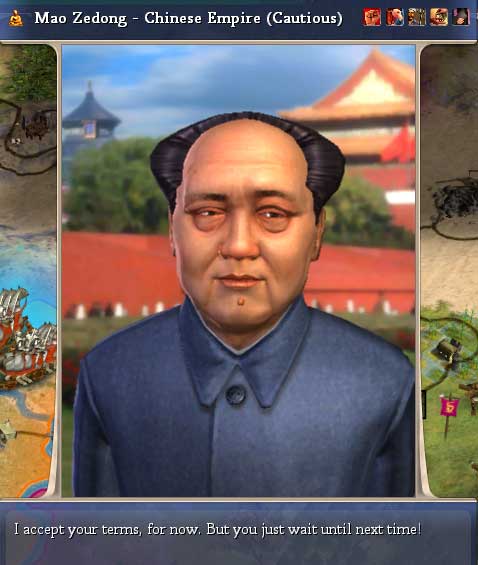Part 13

Schoolchildren walk on an abandoned road, the modern remains of the famous trade route between Shanghai and Grozny.
I sat on a cobble and listened to the farmers talking in pidgin Russangxi, a bizarre blend of Mandarin and Grozny Russian with a spicing of Hindi lexicon. One of the men whispered to his friend, "Ceci permitted me to come inside her yoni. She did not demand me to remove myself," without caring that I was within earshot or that I cradled a microphone and a notepad in my lap. I was part of the deaf landscape, ignorable. For the farmers, linguists with bright clothes were no longer a novel sight--for decades, my urban colleagues and I had listened to such rustic gossip without reaction. Eventually, the Russangxi speakers understood that we weren't interested in what they said, but only in how they said it.
In less than five hundred years since the unification of our great continent, three seemingly irreconcilable languages have meshed into a messy but rich linguistic tapestry. I believe that understanding how our people wove that tapestry will also help us understand how we wove together an empire from such strikingly different threads. But maybe it is as Dedomirishch said, "History's infinite tapestry is woven by unknowably many threads of all colors and qualities, but in our study of it, when we need to center ourselves, we can remember that there is nothing there but thread." And so, in our common threadness, we find unity.
-- The Foreword to Ian Igrashko's Language and Empire: Essays on Russia's Cultural History
A Short History of the Russo-Chinese War
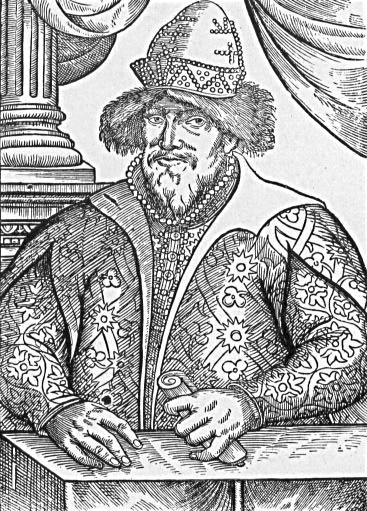
Duke Gaafa VI, seated in the Hindu temple at Shanghai.
By 1100 AD, Russia's feudalistic polities and guilds had effectively undermined the Tsar's bureaucracy, and many of the lords had installed themselves in regional positions of dictatorial power. Some of the most influential polities were capable of raising their own armies, and sensing little need for the state, they threatened to stop paying taxes to Moscow unless they were recognized as seperate grand duchies. Helpless, the Tsar complied, and Russia was broken into twelve provinces ruled by dukes with Peter as their nominal king.
Don't think that the new dukes were driven completely by greed. Even the most coldly practical men like Lord Gaafa V believed that they were looking to protect their interests in a way that the distant and increasingly irrelevant government of Moscow could not. By establishing themselves as the absolute leaders of their own lands, their responses to sudden political needs took days or weeks to arrive, rather than years or decades.
1100 AD - 1150 AD
The final decades before the Russo-Chinese War were hectic. The aging Duke Gaafa VI dumped most of his wealth into the purchase of Novgorod horses from the southern coast of the empire, and what little of his wealth that remained was either reinvested into Grozny or spent on his budding alliance with Duke Uvas, who in recent years had acquired the city of St. Petersburg by crawling to the top of a bloody heap of dead rivals.
Uvas and Gaafa VI combined a force of Grozny knights and St. Petersburg catapults at a camp on the flood plains west of Shanghai, thereby bypassing the traditional but treacherous road between Shanghai and Grozny. Then, in 1050 AD, Gaafa and Uvas ordered their soldiers to march.
Eager to reinstate the lucrative trade routes supported by Hindu-Chinese, the Russians made war on the Buddhist Chinese, and their leader, Mao Zedong.
But why?
On the surface, it seems as if Gaafa VI and Uvas were driven by simple greed. However, their motivation was not the motivation of their serfs and soldiers, and these men could not conquer the Chinese without popular support. Economically speaking, the war had already taken its toll on the Russians long before they even clashed blades with China--most of their grain tributes and taxes were given over to training soldiers, armor crafters, and horses--yet the commoners gladly supported the war effort.
Why? Because the people believed they were defending their religion.
Mao Zedong, a fervent Buddhist and the twelfth Emperor of China, saw himself as a wise and beneficent leader. Shortly after succeeding his father to the imperial throne, he learned about Buddhist Spain's successful theocratic government, which had recently suppressed the dissemination of foreign religions and barbaric influences, and had brought some stability to the religiously fractured Spanish Empire. Under the misguided belief that Chinese culture had perfected itself under his rule, Mao decided to adopt the Spanish model in order to freeze China like a photograph. He rounded up all the non-Buddhist religous leaders and executed them, and when the provinces became discontent, he sent in his troops, overthrew the local governors, and burned their temples.
Unfortunately, Mao did not understand that the Spanish model worked because the Spanish Buddhists were uniformly distributed across Spain. In China, on the other hand, the Buddhists were concentrated along the coasts north of the Yangste Jungle, while the flatlands south of the Gobi Desert were populated almost entirely by Hindus and Confucianists. Instead of uniting his empire, his attempt at theocracy effectively pitted a dense but poor Buddhist North against a rich but sparsely populated Hindu South.
The Hindus were Mao's greatest threat. Even though over three-quarters of the Chinese were Buddhist, the empire's most cultured cities were Hindu, thanks to their close cultural proximity to Russia and India. Eventually, Mao met resistance from within his government, and in a fit of rage he ordered the entire Imperial Court killed, after which he replaced his father's advisors and officers with nobles born in the Buddhist cities of the Yangtse Jungle.
This event incited waves of minor revolts throughout the south in Shanghai, Guangzhou, and the imperial capital, Beijing. In response, Mao mobilized garrisons of thousands of soldiers, which enforced strict curfews and dispersed any public assembly of more than ten people. Though these garrisons were eventually successful, they were often cruel and disruptive, and the economy of the south ground to a halt.
By 1110 AD, all exports from the Chinese south to Russia had stopped. By 1112 AD, the last Chinese caravan had made its way back from St. Petersburg to Shanghai, and it was arrested by Imperial Guardsmen. Mao held the trader in jail for ten years before executing him. In the following decades, Hindu pilgrims who came to Delhi to pray at the Kashi Vishwanath told the Hindus about Buddhist oppression. Most commonly, they said, the Buddhists turned a blind eye while local warlords worked the Hindu peasants like slaves.
With only limited contact, it seemed as if the Hindu south was in need of Russia's military aid. Duke Gaafa V and Duke Gaafa VI both employed religious propaganda in order to motivate their workers around Grozny. Hence, the Russians wholeheartedly believed that they were marching to free the Chinese people from their Buddhist oppressors. Until the Renaissance, the Russo-Chinse war would be called the Gaafa Crusade.
1150 AD - 1200 AD
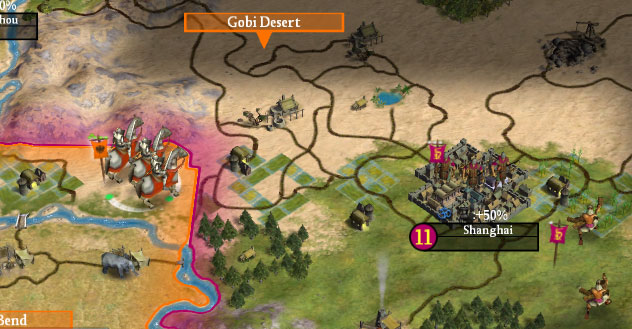
Duke Gaafa VI and Duke Uvas prepare for war.
For almost five years, Mao had been well aware of the Dukes' intentions. However, it was only on the eve of war, after Gaafa VI and Uvas began to march, that he tried to appease them. For each Duke, he sent a bribe of fifty pounds of gold, claiming it was "payment for years of lost trade."
The story goes that Uvas was offended and pulled his warhorse from the stable while Gaafa VI told Mao's messenger that he would free China from the Buddhists. Infuriated, the messenger made to leave with the gold, but Uvas rode his horse into the tent and trod upon the messenger. As the horse's hooves came crashing down, the messenger swore revenge in Chinese, to which Gaafa VI answered with the cry, "Death to tyrants." The horse then crushed the messenger's skull, and Uvas ordered the ruined head cut off and set upon a pike so that he could carry it into battle.
Aside posted:
I demanded that Mao give me all his gold. He responded thusly:
Thanks for the 100 gold, Mao! Now I'm going to rip your ass open with knights and other assorted goodies.

In 1153 AD, Duke Gaafa and Duke Uvas crossed into the Orient with 300 knights (200 from Grozny, 100 from St. Petersburg) and 2 runs of 100 catapults built in St. Petersburg.
Simultaneously, an Indian Duke, descendant of the Godse who killed Ghandi, moved out of Bombay with 800 elephants and 3 runs of catapults from Grozny (the first, third, and fourth) and passed the Sunspine Mountains on his way to Beijing.
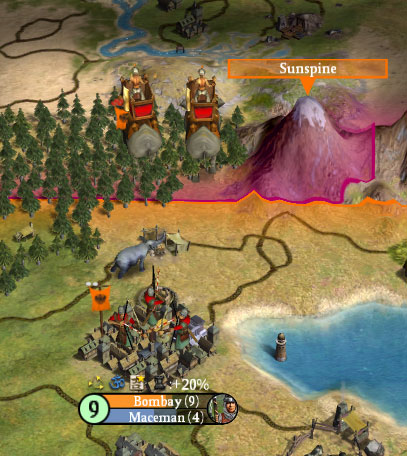
Duke Godse was a student of a much older model of war. Born into a culture obsessed with their defeat at the hands of Russia, it was inevitable that his military studies would focus on the same classical tactics that defeated Ghandi. Unfortunately, these tactics would fare far worse against the more effective defenses of the medieval era.
His streamlined force consisted almost completely of war elephants and catapults, with 800 and 300 of each, respectively.
Aside posted:
I checked with Bismarck, and he traded Theology for the Compass and some gold. I won't add this into the narrative, but I will explain what it is good for when I start building harbors.
Suffice to say, I can build Explorers and Harbors, both of which will have a role in my coming turns.

The Siege of Shanghai
After approaching Shanghai over the flatlands, Dukes Gaafa VI and Uvas set camp amongst the farms west of the city walls, where Hindu sympathizers supplied them with local foods during the duration of the six year siege. This reduced Gaafa VI's supply train to an amazingly small 5 support troops for every 1 fighting soldier: a ratio that wouldn't be matched ever again in world history. With this streamlined and self-supporting system behind him, Gaafa had little difficulty in establishing a military position while the catapults of St. Petersburg began to pick apart the walls of the city.
Meanwhile, Duke Godse met with minor resistence south of the capital, which he dealt with promptly. In the shadow of Sunspine Peak, Godse's second in command, Captain Epish, rode 113 elephants into the garrison around the Beijing iron mines and scattered the surprised defenders in a bloody rout. Even though the Chinese longbows were capable of piercing the elephants' tough hides, there was little they could do to push back the attackers once the elephants were down in the camps and pushing through homes and humans like paper models. Shortly after the initial assault, Godse moved his army into the camp, collapsed the first twenty feet of the mine in order to prevent the Chinese from using it again, and settled out for the winter.
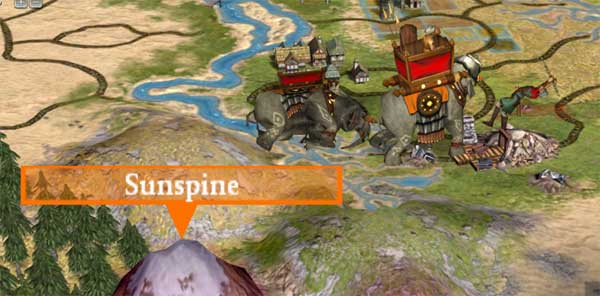
Captain Epish's victory over the longbows defending the Beijing Iron Mines.
During that winter, Mao attempted to disrupt activities around Godse's camp by catapulting his tents, but after only a handful of counter-volleys, the Mao panicked and ordered his troops to return--without the catapults. By spring, the Chinese war machines had been looted for parts or burned as firewood.
The Fall of ShanghaiAside posted:
Mao attacked my elephant stack with a catapult. It damaged five units, putting two of my elephants down from 8 to 7.3 strength, and all three of my catapults from 5 to 4.4 strength. This is hardly a set back, and in fact makes my job a little easier.
In 1179 AD, Duke Uvas's finely machined catapults breached a wide section of Shanghai's city wall.

After sending a horseman to the breach to wave the flag of negotiation, Gaafa VI insisted that the Buddhist government hand over control of the city to the Hindus. The Chinese struck down the horseman with arrows, stapled a message to his chest, and sent the horse running back to Gaafa's camp. The message read, "We will not justify you, we will not legitimize you, and we will not give you a city you intend to steal."Aside posted:
Time to talk about another promotion.
Catapults are great. They deal colatteral damage, they can reduce city defenses, and they've got alright strength when they're introduced in the ancient era.
However, most people make mistakes and don't choose the right promotions, causing them to use catapults with only one promotion--if even that--and almost exclusively for the purpose of slowly whittling away the walls of a city.
I've done two things to fix that: by adopting theocracy, I produce catapults with 6 experience, which makes them level 2. I can therefore choose two promotions, allowing me to select the extremely valuable Accuracy promotion.
I've also selected the proper first promotion. Most people, it seems, believe that you need to select Bombardment (increases collateral damage) as a prerequisite for Accuracy. This is not so: the best first upgrade for a catapult is City Raider I. Not only does this make the catapult a viable unit for attacking and cracking powerful defenders (by allowing the unit to deal more damage as it fights), it also leads to the accuracy promotion.
By selecting City Raider I as your first promotion, you often create a unit that you can attack an ancient city with without dying in the process. Then you'll have the necessary experience to get accuracy on that catapult.
Accuracy is fantastic. It increases the damage from bombardment by +10%. In game terms, instead of spending 8 catapult-turns to wipe out the defense of a wall (50% defense), you can spend 4. In my case, I brought two catapults, both of which have accuracy. They required only two game-turns to wipe out Shanghai's defenses.
After reading the message, Duke Uvas ordered his men and the knights of Grozny under Lord Kavkaz to don their armor. In midafternoon, Lord Kavkaz lined up his knights outside of longbow range along the breach, and waited for a signal from Duke Uvas. The knight's plate armor reflected dully in the sunlight, and from the walls of Shanghai, one man described them as "a shining line painted on the horizon in the colors of steel."
Duke Uvas blew a trumpet, and Lord Kavkas drove his knights into range of the longbows. The initial volley was fired blind by the city's more experienced defenders, and in a horrible moment it seemed as if Lord Kavkaz had been slain by arrows before leading his men into the city; but as the chaos cleared, Lord Kavkaz rose from his felled horse and pulled himself onto another soldier's stallion. Over the panicked and confused commands of his lieutenants, he siezed control by rushing out ahead of his men and drawing the fire of the less experienced longbowmen crowded along the wall near the edge of breach. Recognizing him as he charged ahead, Lord Kavkaz's fellow knights followed after him and into the breach, where they met the mass of longbowmen. At this range, the warhorses and the knight's swords were an extreme threat, and in a handful of bloody minutes, the initial defenders were scattered and retreating from the Russian knights, with only a few men left on the walls to harass the invaders. However, the local Chinese commander was not a complete fool; recognizing the dangers of fighting the well armed and armored knights, he had ransacked the armory and found an old set of bronze spears to use against the Russians. Despite their age, these weapons proved effective. A second wave of defenders set up in the streets a couple of dozen yards into the city proper and faced the knights with makeshift pikes--the spears were tied to the ends of poles--and unable to advance, Lord Kavkaz was forced to retreat from the harrassment of the remaining longbowmen.

Lord Kavkaz leaves the city after scattering the initial bow defenses, only to be stopped by spearmen.
Regrouping, Lord Kavkaz met with Duke Uvas, and together they charged in number. The Duke's idea was simple--if there were too many defenders, then they'd supply so many attackers that the spearmen would either have to spread out and become ineffective, or they'd have to leave certain streets undefended.
Or, better put, the Duke's idea was too simple. As the knights spread out behind the breach, it became more difficult to coordinate their movements against the defenders. The defenders, on the other hand, were well-versed in the layout of the city, and moved easily to respond to the Uvas's slowly maneuvered flanking attempts. Uvas was only a brilliant thug, not a military commander, and after almost twenty minutes of fighting under arrow fire from the walls, he made a rash decision: he ordered a charge right down Shanghai's main road, into a band of over seventy spearmen defending a market. Among the trecherous terrain of the downed stalls, the horses faltered in their charge, giving the spearmen the initiative. Well over half the knights in the charge will killed under their dying horses. Reportedly, Duke Uvas leapt off his mount and made his way into combat on foot. His armor, still kept in a museum in Shanghai, bore two marks, likely the places where the points of spears were deflected by the thick iron plating. However, at that range, he was quickly mobbed, and a knife was jammed into his visor. He screamed so foully that several of the knights broke and fled, and he was only silenced when his assailant pulled the knife from his sinuses, releasing a torrent of blood and choking the duke on his own fluids.
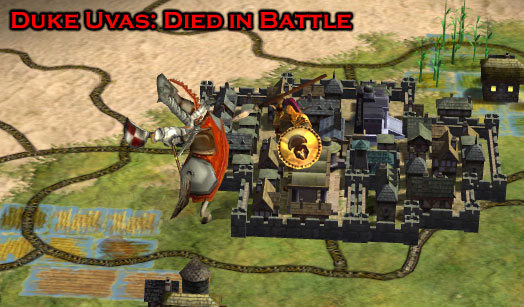
However, the Duke's death was not a total loss. One of his lieutenants, Yegor the Righteous, took to his own initiative and, with the help of Lord Kavkaz and a few other loyal men, scaled the edge of the breach to reach the tops of the walls. A handful of people were killed on the climb, but Yegor and Kavkaz both managed to reach the remaining defenders. The longbowmen were armed with short swords in case of close combat, but now the true technological advantage of knights became clear. Knights wore plate armor, which was far too expensive to craft for the average solider--until, that is, the invention of guilds. Guilded labor was capable of manufacturing high quality plate armor in reasonable quantities, which meant that Yegor and all his men wore an inch of iron, while the Chinese wore little more than a leather jerkin or a chainmail shirt. In thirty minutes, Yegor and seven other people systematically butchered 42 enemy soldiers without suffering but one wound.
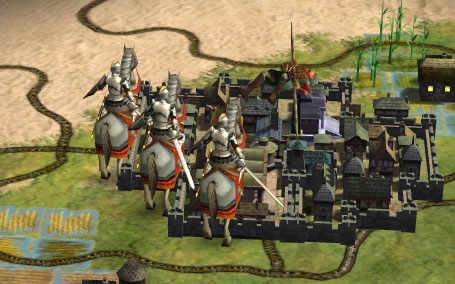
Yegor defeated the last of the longbowmen without taking a single loss.
After learning of Yegor's tactical victory, Duke Gaafa and Lord Magnus of Crimea ordered their knights to dismount at the head of Shanghai's main street, so that upon approach to the market they would be able to maintain a disciplined regiment. The spearmen were backed by Cho-Ko-Nu, a type of clever Chinese crossbow capable of firing multiple shots per a minute. However, the draw on the Cho-Ko-Nu was too low to pierce the plate armor, and only three men died before combat was met in Shanghai's marketplace.Aside posted:
A quick note: I'm promoting these knights with the Combat I and Combat II promotions, giving them a total of +20% strength. This gives them 12 strength--more than enough to kill a longbowman.
Furthermore, Knights are immune to first strikes. This makes them great at cracking archers and other defenders.
Since knights move 2 tiles rather than 1, Yegor the Righteous--which I built after I'd already started the war--managed to join in the fight for Shanghai at the end of its second turn of movement. Never underestimate the power of good movement, especially in a normal speed game (where every turn counts).
Under Gaafa's command, Magnus broke off from the side of the regiment with a band of fifteen knights, and he moved around a side alley until he clashed with the Cho-Ko-Nu. In these dim places, there was nothing the Chinese could throw at Magnus except bravery, and in these dim places, bravery was nothing at all. Any Cho-Ko-Nu that weren't put to the blade simply vanished into Shanghai's streets, never to be seen again.
Duke Gaafa VI pushed into the crowd and began to hack at the lightly armored spearmen. Uvas's final charge had broken most of the spears, leaving the spearmen with wide gaps in their line and few alternative weapons except for knives, meat cleavers, and clubs made from the pieces of fruit stands. Excluding the meat cleavers, none of these were even capable of piercing plate mail. So with cool, regimented precision, Gaafa pressed forward and casually chopped men's shoulders in twain. In fifteen minutes, the Chinese morale finally broke, and they fled the market. By the time Gaafa had reached the square, the Buddhist officials were in the process of drafting their surrender to the Russians.
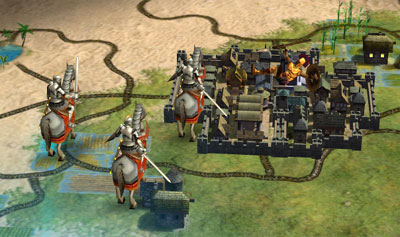
Shanghai is captured.
Though Duke Gaafa VI was a considerate man who preferred life over death, he understood the methods of war. Within a week of taking Shanghai, he rounded up all the military commanders and Buddhist officials of any power and had them publicly executed, along with their families, their friends, and their business associates. Within two weeks, the entire noble class had been sliced out of Shanghai, and into that power vaccuum slipped the Russian knights.
But the most telling moment, I think, came a month after he had conquered Shanghai. He was sitting at a table in the local temple and writing a new law when the head priest asked him, "When will you restore the Hindu government?"
He turned to the priest, raised his eyebrows as if he were completely confused, and said, "What do you mean? We've had a Hindu government for a month."
Though this part is probably a story made up by Chinese nationalists, it is said that the Hindu priest fell to his knees and began to cry.
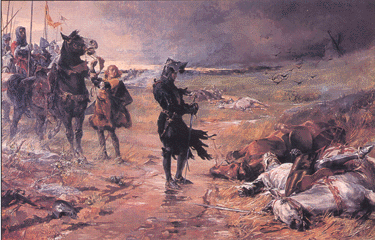
The battle of Shanghai is over, and the dead are lined up to be identified by their comrades.
The Slaughter at Beijing
While Shanghai fell, Duke Godse approached the Chinese capital with his elephants and catapults, and for a time, it seemed as if there was no defense against Russian's relentless army. He laid siege to Beijing in the same winter that Duke Gaafa VI passed his title to his own son, and declared himself the new governor of Shanghai. At the same time, Captain Epish remained behind to pillage the iron mines for equipment.
In the following years, Duke Godse bombarded Beijing until the city's resources were exhausted and the breaches could not be repaired. Then, on an August afternoon, he followed the model that had crushed Delhi and ordered the fourth Grozny catapults into range to fire grapeshot at the longbowmen defending the city. Before the catapults had fired one volley, the superior range of the longbows allowed the Chinese to fire oil-soaked burning arrows at the war machines. The crews retreated, and that night, all the countryside could see the orange glow of blazing wood.Aside posted:
Pillaging! Basically, you can pillage an improvement on the map (I haven't really described improvements, have I?) in order to earn a small amount of gold. However, I'm pillaging the mine because I'm moving my units off of the tile, and the turn that happens, Beijing will be able to use the hammers from the mine to build more defenders.
By pillaging the mine, I may slow his defense production enough to prevent him from making any more longbowmen in his capital. Oh, I can only hope!
Unfortunatey, pillaging uses up one movement point, which means that poor old Captain Epish will have to sit all alone on the pillaged tile while the rest of the army moves into position south of Beijing.
Unperturbed by the failure of his catapults, Godse urged his animals forwards into the breach. He imagined that the Chinese capital was less effectively defended than the old cities of India, since there were no earthworks to cross and only a single wall to be breached. He simply couldn't imagine a medieval military where bow range and effective regiments trumped the strength and terror of slow, clumsy animals like the elephants.
Captain Epish charged first, and as his elephants funneled into the gap along the Beijing wall, the Chinese fired upon him. Though Epish was a brilliant tactician and an expert marskmen, his shortbows simply couldn't match the power and range of the longbow, and over time, the entire charge ground to a halt in the ring of land between the city and the wall. Epish's elephants were either frenzied, frozen with fear, or dead, and under a constant rain of arrows, there was nothing Epish could do but stand and eliminate as many Chinese as he could. For two hours they exchanged fire and extremely heavy casualties, until Epish's elephant finally frenzied and crashed into the wall, eliminating several longbowmen and dashing Epish across the stones like an uncooked blood sausage thrown off a tower.

While Epish charged to his death, Captain Rammi, Godse's brother-in-law, moved south along the wall and moved his elephants between a smaller gap. Though he could only move one elephant through at a time, he was unharrassed during his entrance, and managed to make his way well into Beijing before he met up with a regiment of pikemen. If he'd stumbled across them any later, he would have lost. Even in their disordered state, the pikemen were capable of piercing an elephant's chest or picking out an elephant's drivers like grubs on the end of a fork; but because he arrived when they were unready, he ground the lot of them into the cobbles, but at a tremendous loss in both elephants and trained soldiers.
Treading over Epish's bloody corpse, Captain Eppir met only mild resistance. Though the longbows were superior, they were easily outnumbered by Eppir's elephant-archers, leading to the quick and brutal defeat of the remaining Chinese longbowmen. They died under a spray of thick Russian arrows launched from shortbows.Aside posted:
Yay. That fight had a 28% chance of victory, but Captain Rammi pulled through and eliminated those pikemen bastards. It seems that Bismarck got Engineering last turn, he traded it to Mao *along with a ton of money*, and Mao upgraded his only spearman to a pikeman. Thankfully, the pikeman is dead. I only hope I can break this city and eliminate the last iron source in his territory before he builds more of them.
Seeing the defenders driven from the walls, Duke Godse lead the final assault of three hundred elephants into Beijing. As Captain Ramov described it in his journals, "It was as if the buildings and the alleys sprouted spears and arrows, and the entire city was an animal clawing and baring its fangs."
In the last great battle of elephant warfare, Godse fought against a regiment of Imperial Guardsmen armed with pikes and grapeshot catapults in the close quarters of the courtyard before the Imperial palace. As his elephant died from a blast of grapeshot to the face, Godse is imagined in modern paintings to have stood upon the head of his fallen beast with a sword in his hand, screaming at the palace doors while elephants around him are pierced by pikes. No record actually exists to prove this is anything more than a myth; but it is certain that many men died in that fight, yet Mao was not captured or found. The Imperial Palace had been abandoned, and in the end, Duke Godse had slaughtered more elephants in one day than had died in the entire Russo-Indian war, and he had gained only one city.
It is also clear that Duke Godse was well aware of his own failings by comparison, and though he'd taken the Chinese capital with nearly obsolete military technology, he soon drank himself into a stupor and committed suicide with his own sword. It was written that they tried to bury him with dignity, but somehow, in his undeserved self-loathing, he'd managed to radiate shame even as a corpse.
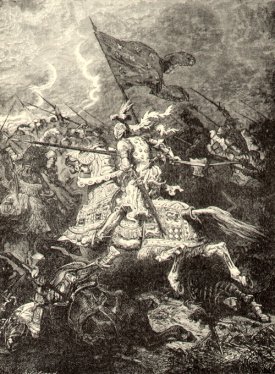
Title: The Last Ride of Uvas
So far...
Wow. This was a long post. I've ignored the technology I *just* finished researching; that technology will be explained at the start of the next update, and it'll be followed by more of the Russo-Chinese war.
See you tomorrow...

